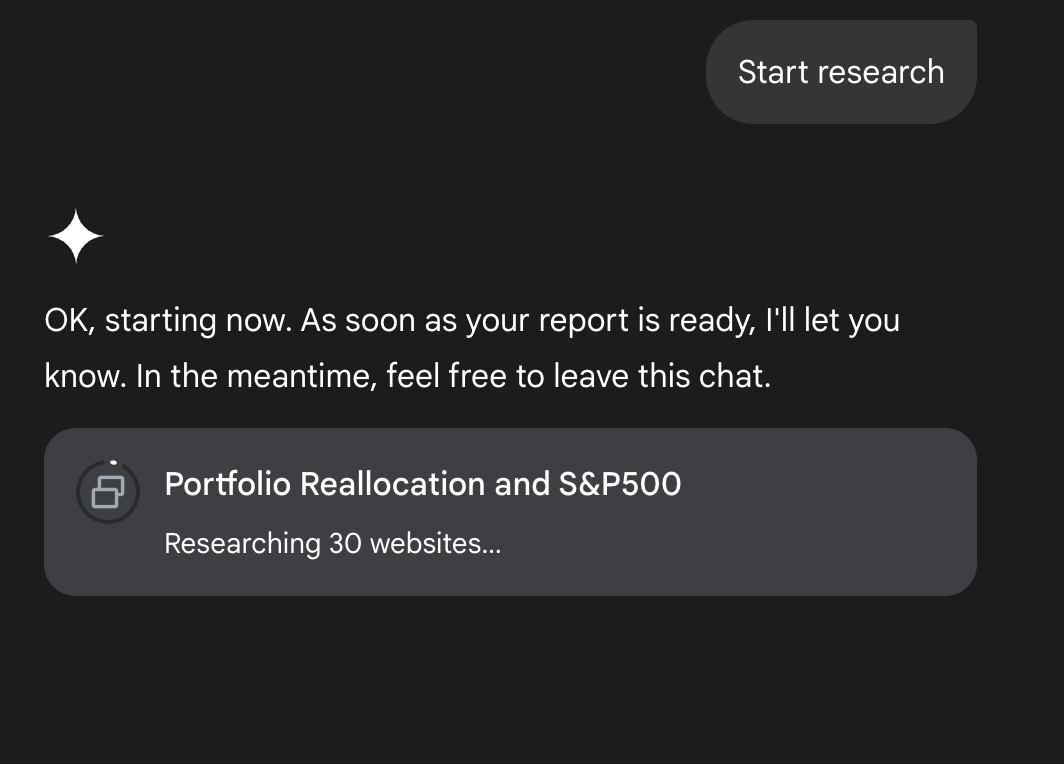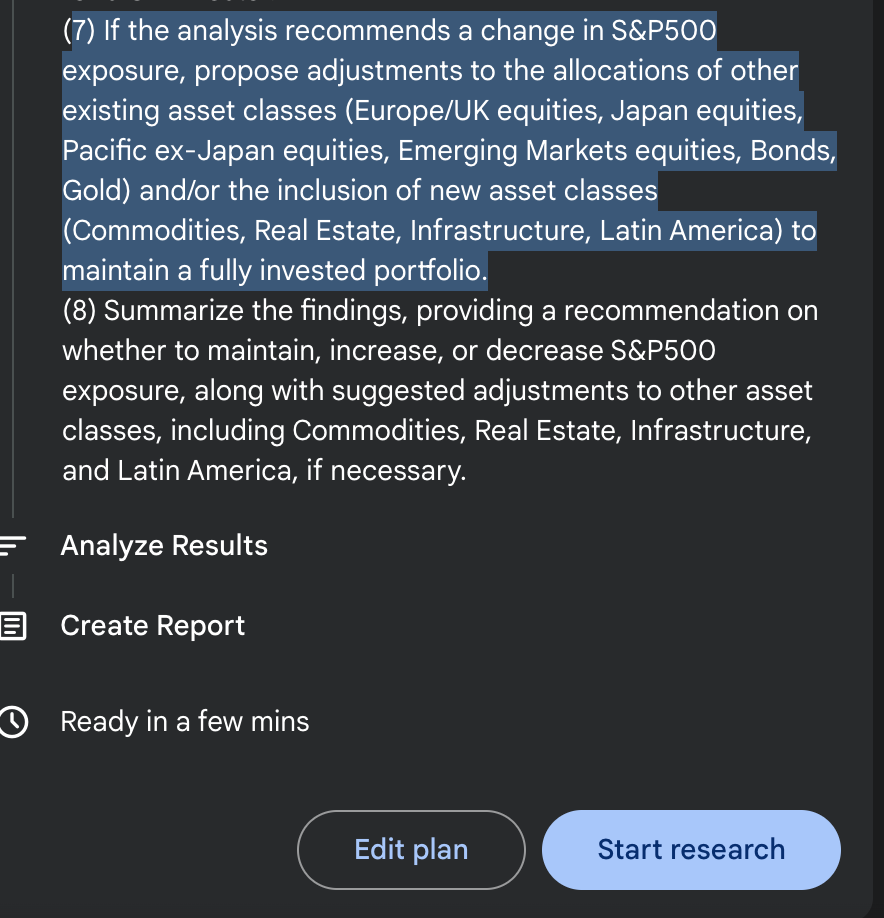Gemini Deep Research - Asking about S&P500 exposure
Google Gemini has a Deep Research feature which I wanted to try, so I asked for an analysis to consider if my existing S&P500 index should be maintained, increased or decreased.
Google Gemini Deep Research is marketed as saving hours of work as your personal research assistant. It is an Agentic system that works on complex problems by:
Breaking down the problem into a series of smaller, manageable sub-tasks.
Researching using tools like web browsing to fetch information & reason over it.
Synthesis of the findings into a comprehensive report.
Last week, I wrote about using ChatGPT Deep Research to create a report on the S&P exposure of my portfolio.
So let’s try a similar complex task with Gemini.
My Prompt
Using the Gemini Web App, I selected the 2.0 Flash model and clicked the Deep Research button and entered the following prompt:
I need an analysis to help me decide if I should maintain, increase or decrease my portfolio’s exposure to the S&P500 index. My current allocation is 75% Equities, 20% Bonds and 5% Gold. The Equities component consists of 50% S&P500, 25% Europe (including UK) with the remaining 25% split equally between Japan, Pacific (excluding Japan) and Emerging Markets (including China). So my S&P500 exposure is 37.5% of my total portfolio, as it is 50% of my Equities allocation, which itself is 75% of the portfolio. Note that my investment horizon is medium term, my risk tolerance is medium, and I am UK domiciled investor. If the analysis recommends a change from the current S&P500 exposure, it should also propose which other exposures should be added, increased or decreased to keep the portfolio fully invested.
A bit long, but as we have seen before, providing appropriate details for complex tasks is helpful in getting better responses.
The Research Plan
The response was as below:
Research, Analyse and Create Report.
Looks goods to me.
Expanding on the More (under Research Websites) had the following sub-tasks:
Research the current economic outlook and growth forecasts for the US economy over the medium term.
Investigate the current market sentiment and analyst ratings for the S&P500 index.
Analyze the current economic outlook and growth forecasts for Europe (including the UK), Japan, Pacific (excluding Japan), and Emerging Markets (including China) over the medium term.
Compare the projected returns and risks of investing in the S&P500 versus other major equity markets, considering a UK-based investor's perspective and potential currency fluctuations.
Evaluate the current and expected role of bonds and gold in a balanced portfolio, considering prevailing interest rates and inflation expectations.
Based on the above research, assess whether the current 37.5% allocation to the S&P500 aligns with a medium-term investment horizon and medium risk tolerance for a UK investor.
If a change in S&P500 exposure is suggested, explore potential adjustments to the allocations of other asset classes (Europe/UK equities, Japan equities, Pacific ex-Japan equities, Emerging Markets equities, Bonds, Gold) to maintain a fully invested portfolio.
Summarize the findings, providing a recommendation on whether to maintain, increase, or decrease S&P500 exposure, along with suggested adjustments to other asset classes if necessary.
Looks pretty good to me.
There is a button to Edit Plan, which I clicked on and entered the following:
In (7) include the possibility of adding assets that are not in the existing portfolio
Which promptly changed sub-task 7 to:
If a change in S&P500 exposure is suggested, explore potential adjustments to the allocations of other existing asset classes (Europe/UK equities, Japan equities, Pacific ex-Japan equities, Emerging Markets equities, Bonds, Gold) or the addition of new asset classes to maintain a fully invested portfolio.
Very nice.
Start Research
Next I clicked Start Research, which opened a panel on the left showing:
while the main panel shows thinking:
These sites, certainly look like credible choices e.g. imf.org, oecd.org, morningstar.com, …
And as the sub-tasks were performed I could scroll down this page.
While the left hand panel kept updating.
Now up to 176 websites!
After 6 minutes this changed to show “Creating your report”
And after another minute this panel showed:
Nice, not only is the report available but a prompt is provided for follow-up questions or changes.
With the main panel updating to show the report.
Let’s take a look at this.
The Report
The full report can be read here.
Either you can read it now or continue below for my analysis.
I show the Executive Summary below.
Recommendations
The first thing that stands out, is that it recommends a decrease of S&P500 exposure with the capital re-allocated to increasing Europe (inc UK) and Japan exposures.
Certainly very different from the ChatGPT recommendation to maintain.
And in the body of the report, I found the following:
Maintain Bonds at 20%
Maintain Gold at 5%
Maintain Equities at 75%
S&P500 down to 33% from 50%
Europe (inc UK) up to 33% from 25%
Japan up to 13% from 8%
Pacific (ex JP) up to 10% from 8%
Emerging Mkts (inc China) up to 10% from 8%
So the S&P500 allocation is significantly reduced, with most of this going to Europe (inc UK) to get to the same allocation percentage (1/3 of equities), while each of the rest are increased too.
A surprisingly bold call given that in the MSCI World Index, the US has a 70% weighting.
Looking at these recommendations I am not sure if the analysis considered other asset classes such as Commodities, Real Estate or Infrastructure or indeed other regions e.g. Latin America.
Let’s ask it.
When I did this, it came up with an amended plan, see sub-task 7.
So I clicked on Start Research again.
This produced a new shorter report focusing on the new asset classes I mentioned, again recommending a decrease in S&P500, but this time recommending all of the released capital being invested in global infrastructure, broad commodity index, diversified emerging markets including Latin America and global UK/European REITS.
So while these should add more diversification to the portfolio, always a good outcome, it does seem to have taken by addition literally, in that I did not necessarily want it to add exposures to all of these, just consider them and add a few.
Either way, the recommendations are interesting and credible.
However, lets now turn to what is as important to me, the research and analysis in the report.
Research and Analysis
The report body is 3,250 words over 9 pages, include one table, followed by 5 pages listing all the sources cited. The number of sources at 66 is very impressive and all look credible from investment banks to the official sector.
Looking at the specific sections:
The Executive Summary at 140 words is good, clearly states at the end “Considering the risk-adjusted return prospects compared to other global equity markets, particularly Europe and Japan, a decrease in the S&P500 exposure is recommended. The capital should be reallocated to increase exposure to European (including UK) equities and Japan equities, while maintaining allocations to other asset classes.” - without giving away the detail of the percentages, which is good as makes the reader need to read the report.
Next the prompt is re-stated to introduce the report analysis.
The “Medium-Term Economic Outlook and Growth Forecasts for the US” is good with figures on economic growth from multiple official sources. Inflation is discussed including the impact of tariffs, The section ends with risk on the outlook. Overall I find this section informative, with 16 references for further reading.
Next “Current Market Sentiment and Analyst Ratings for the S&P500 Index”, which is up to date and covers both the positive outlook and recent downgrades in forecasts. The focus on analyst ratings and year end forecasts is fine, but what I find surprising is the lack of comment on current PE multiples compared to historic PEs, let alone CAPE.
There follow sections on Europe, Japan, Pacific and EM, which are similarly reference heavy on economic outlook and then add commentary on the stock market.
The “Comparative Risk-Adjusted Return Analysis” starts with the following, “Historical performance data indicates a cyclical nature to the outperformance of US versus international equities 60. While the S&P 500 has enjoyed a period of strong relative returns since the Global Financial Crisis, driven by robust earnings growth, valuation expansion, and a strengthening US dollar, its current valuation levels are considered high 60. This suggests that future returns from the S&P 500 might be more moderate.” - all very nicely explained.
And follows with, “In contrast, European equities are currently trading at a valuation discount compared to the US market 35 and offer the potential for improved earnings growth in certain sectors 63. Similarly, Japanese equities are also trading at a discount and are benefiting from ongoing corporate reforms aimed at enhancing shareholder value”
Which form the basis of the recommendations
Good points on currency risk of a GBP investor to JPY and USD are mentioned.
The one table in the report is useful (I won’t re-produce it here)
The recommendation details are covered on one page with explanations, which are good, my only criticism of these are that the percentage allocations for equity regions are stated as percent of the total portfolio, so I had to transform these to percentage of equities, as more natural to express that way e.g. Europe (inc UK) should be increased to 33% of Equities, rather than 25% of total.
I could go on, but will stop there
The full report is available here.
Thoughts
In general I like the report.
Lots of credible sources, good analysis and a bold recommendation.
All produced in 7 minutes.
And the ability to ask questions to go deeper.
What’s not to like?
Certainly better than the one I got from ChatGPT last week.
What could have improved it?
Certainly a few charts.
Possibly the feel is a bit “academic research paper”, which is no bad thing, but different to general investment writing.
For my personal use, I like the report and as I keep up with the financial press, I can critically read it to guard against made-up hallucinations.
For an analyst at an Investment Bank or Wealth Manager, it may also be helpful on economic outlook but they would want to focus only their own firms forecasts and not competitors, consequently would still require a lot of editing.
Learnings
Gemini Deep Research has impressive capabilities.
It is fast and searches hundreds of credible sources.
The analysis resulted in a change allocation recommendation, which is good, when the easy option is to return with do nothing.
Though any financial advice should be checked with independent sources.
For this use case I found Gemini superior to ChatGPT.
You can try Gemini Deep Research at no cost.
I recommend you do so.
As for me, I need to think on my S&P500 position at parity to Europe (inc UK).
That’s a tough one, given historical performance.
But then history may not be the best guide.
Stop.












